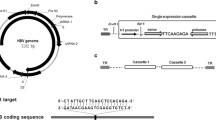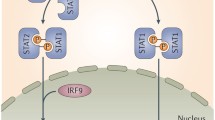Abstract
Experimental studies have demonstrated that the triple combination of amantadine (A)/ ursodeoxycholic acid (UDCA, U)/ biphenyl dimethyl dicarboxylate (DDB, D) might have a preferential antiviral effect compared with that observed in interferon-induced antiviral signal pathways, such as those of STATIα and the 6-16 genes. To confirm the results, this study examined whether the signal transduction for the antiviral activity in HepG2 2.2.15 was induced dependently or independently of interferon. To accomplish this, the correlation between the STATIα and 6-16 genes, and nitric oxide, for the mediation of the antiviral activity was assessed. The increase in nitric oxide in the UDCA groups suggests that the inhibition of viral gene replication was enhanced by the amantadine combinations (AU and AUD), and might be more effective if incubated for longer periods. It was found that STATIα was activated by the amantadine combination, although to a lesser extent than that of interferon-α, and the primary endpoints examined for the inhibition of gene expression (HBsAg and HBcAg) were remarkably well regulated. This suggests that the amantadine triple, or at least the double, combination had better clinical benefits than those of IFN-α and the nucleoside analogue single treatment. This demonstrates that the amantadine combination might be a substitute for the existing HBV therapy if the results ofin vivo and in vitro studies concur.
Similar content being viewed by others
References
Abdelmalek, M. F., Harrison, M. E., Gross J. B., Poterucha, J. J., Gossard, A. A., Spivey, J. R., Rakela, J., and Lindor, K. D., Treatment of chronic hepatitis C with interferon with or without ursodeoxycholic acid: a randomized prospective trial.J. Clin. Gastroenterol, 26, 130–134 (1998).
Asmuth, D. M., Nguyen, H. H., Melcher, G. P., Cohen, S. H., and Pollar, R. B., Treatments for hepatitis B.Clin. Infect. Dis., 39, 1353–1362 (2004).
Beasley, R. P., Hepatitis B virus. The major etiology of hepatocellular carcinoma.Cancer, 61, 1942–1956 (1988).
Bonkovsky, H. L., Therapy of hepatitis C: Other options.Hepatology, 26, S143–151 (1997).
Bose, S., Kar, N., Maitra, R., Didonato, J. A., and Banerjee, A. K., Temporal activation of NF-κB regulates an interferon-independent innate antiviral response against cytoplasmic RNA viruses.Proc. Natl. Acad. Sci. U.S.A., 100, 10890–10895 (2003).
Chiu, P. Y., Tang, M. H., Mak, D. H. F., Poon, M. K. T., and Ko, K. M., Hepatoprotective mechanism of schsandrin B: Role of mitochondrial glutathione antioxidant status and heat shock proteins.Free Radical Res., 35, 368–380 (2003).
Clercq, E. D., Antivirals and antiviral strategies.Nat. Rev. Microbiol., 2, 704–720 (2004).
Clercq, E. D., Perspectives for the treatment of hepatitis B virus infections.Int. J. Antimicrob. Ag., 12, 81–95 (1999).
Cotonat, T., Quiroga, J. A., Lopez-Alcorocho, J. M., Clouet, R., Pardo, M., Manzarbeitia, F., and Carreno, V., Piolt study of combination therapy with ribavirin and interferon alfa for the retreatment of chronic hepatitis B e antibody-positive patients.Hepatology, 31, 502–506 (2000).
Darnell, J. E., Kerr, I. M., and Stark, G. R., Jak-STAT pathways and transcriptional activation in response to IFNs and other extracellular signaling proteins.Science, 264, 1415–1421 (1994).
Davey, S., State of the world’s vaccines and immunization. Geneva: World Health Organisation, 76–82 (1996).
Fabris, P., Tositti, G., Mazzella, G., Zanetti, A. R., Nicolin, R., Pellizzer, G., Benedetti, P., and de Lalla, F., Effect of ursodeoxycholic acid administration in patients with acute viral hepatitis: a pilot study.Aliment. Pharm. Ther., 13, 1187–1193 (1999).
Findor, J. A., Daruich, J. Z., and Bruch, I. E., Amantadine HCI alone and associated with recombinant alpha I FN 2a during a short term therapy in chronic HCV infection.Hepatology, 26: 217A (1997).
Guidotti, L. G., McClary, H., Loudis, J. M., and Chisari, F. V., Nitric oxide inhibits hepatitis B virus replication in the livers of transgenic mice.J. Exp. Med., 191, 1247–1252 (2000).
Hancke, J. L., Burgos, R., and Ahumada F., Schisandra chinensis (Turcz) Baill.Fitotherapia, 70, 451–471 (1999).
Huber, R., Hockenjos, B., and Blum, H. E., DDB treatment of patients with chronic hepatitis.Hepatology, 39, 1732–1733 (2004).
Koulentaki, M., Notas, G., Petinaki, E. Valatas, V., Mouzas, I. A., Castanas, E., and Kouroumalis, E. A., Nitric oxide and proinflammatory cytokines in acute hepatitis B.Eur. J. Int. Med., 15, 35–38 (2004).
Lindenmann, J., From interference to interferon: a brief historical introduction.Philos. T. Roy. Soc. B., 299, 3–6 (1982).
Locarnini, S. and Birch, C., Antiviral chemotherapy for chronic hepatitis B infection: lessons learned from treating HIV-infected patients.J. Hepatol., 30, 536–550 (1999).
Lowenstein, C. S., Dinerman, J. L., and Snyder, S. H., Nitric oxide: a physiologic messenger.Ann. Intern. Med, 120, 227–237 (1994).
Neuman, M. G., Blendis, L. M., Shear, N. H., Malkiewicz, I. M., Ibrahim, A., Katz, G. G., Sapir, D., Halpem, Z., Brill, S., Peretz, H., Magazinik, S. M., and Konikoff, F. M., Cytokine network in nonresponding chronic hepatitis C patients with genotype 1: role of triple therapy inth interferon alpha, ribavirin, and ursodeoxycholate.Clin. Biochem., 34, 183–188 (2001).
Platania, L. C. and Fish, E. N., Signaling pathways activated by interferons.Exp. Hematol., 27, 1583–1592 (1999).
Reiss, C. S. and Komatsu, T., Does nitric oxide play a critical role in viral infection?,J. Virol., 72, 4547–4551 (1998).
Sells, M. A. and Chen, M. L., Acs, G., Production of hepatitis B virus particles in HepG2 cells transfected with cloned hepatitis B virus DNA.Proc. Natl. Acad. Sci. U.S.A., 84, 1005–1009 (1987).
Stuyver, L. J., Lostia, S., and Adams, M. etal. Antiviral activities and cellular toxicities of modified 2,3-dideoxy-2,3-Didehy-drocytidine analogues. Antimicrob. Agents Chemother., 3854–3860 (2002).
Trauner, M. and Graziadel, I. W., Mechanisms of action and therapeutic applications of ursodeoxycholic acid in chronic liver diseases.Aliment. Pharmacol. Then, 13, 979–995 (1999).
Wharton, S. A., Belshe, R. B., Skehel, J. J., and Hay, A. J., Role of virion M2 protein in influenza virus uncoating: specific reduction in the rate of membrane fusion between virus and liposomes by amantadine.J. Gen. Virol., 75, 945–948 (1994).
Zhu, H., Zhao, H., Collins, C. D., Eckenrode, S. E., Run, Q., Mclndoe, R. A., Crawford, J. M., Nelson, D. R., She, J. X., and Liu1, C., Gene expression association with interferon alpha antiviral activity in an HCV replicon cell line.Hepatology, 37, 1180–1188 (2003).
Author information
Authors and Affiliations
Corresponding author
Rights and permissions
About this article
Cite this article
Joo, S.S., Lee, D.I. The potential anti-HBV effect of amantadine in combination with ursodeoxycholic acid and biphenyl dimethyl dicarboxylate in HepG2 2.2.15 cells. Arch Pharm Res 28, 451–457 (2005). https://doi.org/10.1007/BF02977675
Received:
Issue Date:
DOI: https://doi.org/10.1007/BF02977675




